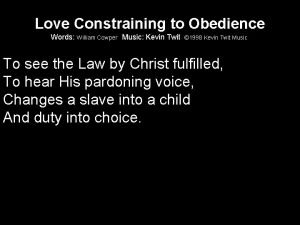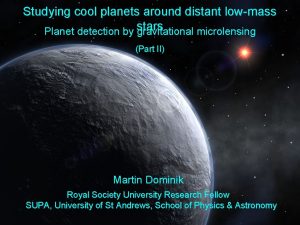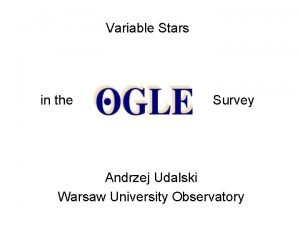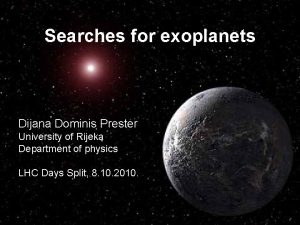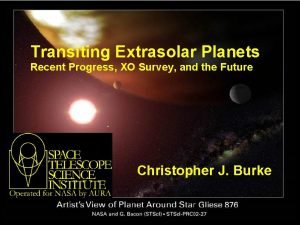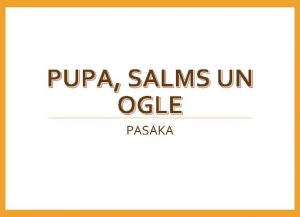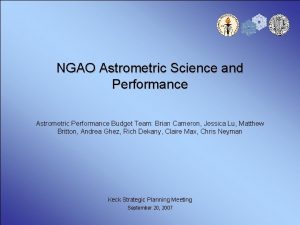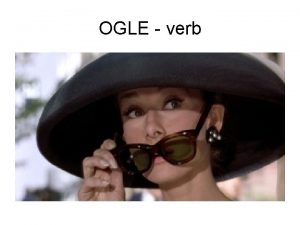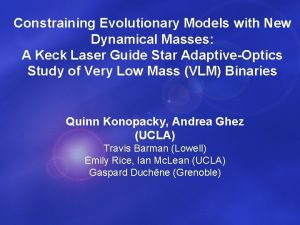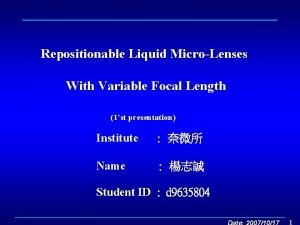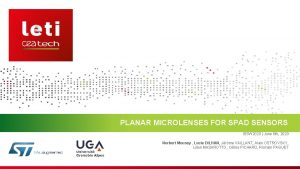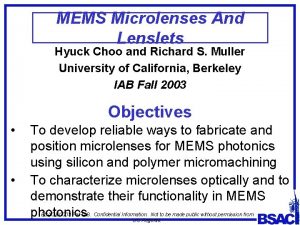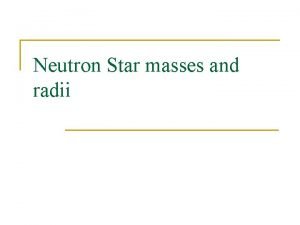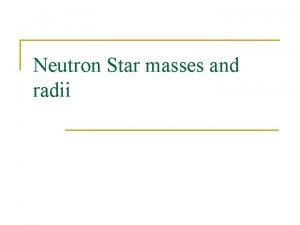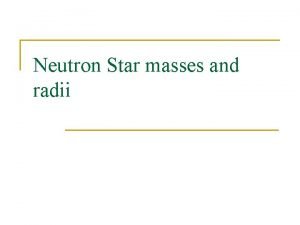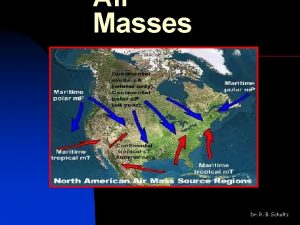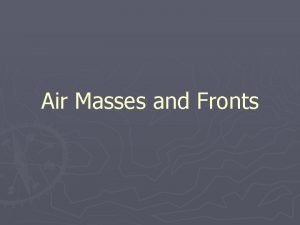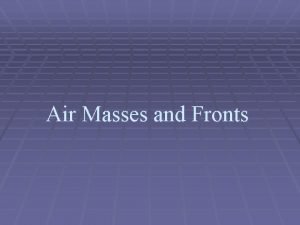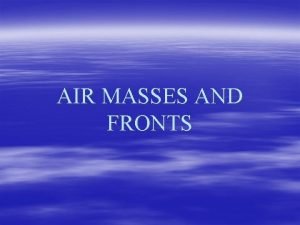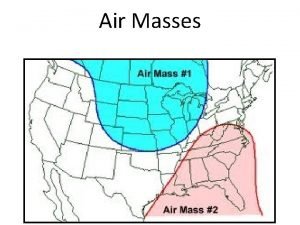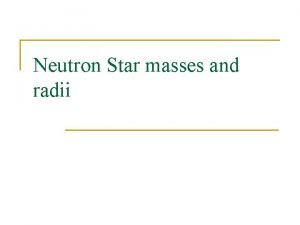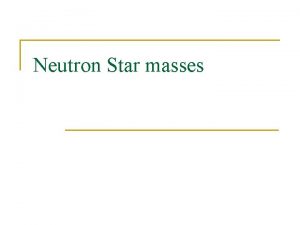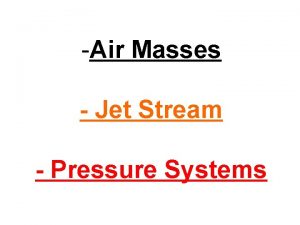Constraining the masses of OGLE microlenses with astrometric




































- Slides: 36

Constraining the masses of OGLE microlenses with astrometric microlensing Noé Kains (STSc. I) with Kailash Sahu, Jay Anderson, Andrzej Udalski, Annalisa Calamida, Stefano Casertano

A key problem in microlensing • Lens masses are generally not tightly constrained by modelling • Instead, only mass ratio + sometimes some additional constraints; direct mass measurements are rare • Improving on that on a routine basis would help us understand better • Planet mass function (Gaudi+ 2002, Tsapras+ 2013, Gould+ 2006, Sumi+2010, Gould+ 2010, Cassan+ 2012, Suzuki+ 2016, Shvartzvald+2016, Tsapras+ 2016) • Black hole demographics (Agol 2002, Bennett 2002, Lu+ 2016, Wyrzykowski+ 2016, Kains+ 2016)

Measuring masses of isolated objects t. E = θE /vang • t. E is proportional to M 1/2 ; typical t. E for lens of ~0. 5 M is 40 days, ~a few M is ~80 -100 days • But t. E is a degenerate function of source velocity, lens mass, and lens/ source distances • Long t. E could be due to • Large lens mass; • Close lens; or • Small lens-source motion • Mass is a function of θE and lens/ source distances • How to determine those parameters to obtain a mass measurement?

Determining the lens distance • The source distance is usually determined either by assuming it is in the Bulge, or by determining it from photometry • The lens distance can sometimes be determined using parallax • “Ground” parallax: orbital or terrestrial (e. g. Dominik 1998, Gould+ 2004) • “Space” parallax (e. g. Refsdal 1966, Dong+ 2007, Yee+ 2015)

Orbital parallax • The Earth’s orbit around the Sun can be detected in the light curve if t. E is large enough, u 0 is small enough • Parallax is fitted from the light curve so requires good time resolution and precise photometry; • Yields πE = πLS/θE; with DS DL

Terrestrial parallax • Event observed from two (or more) distant observatories on Earth (Gould 1992) • If the event is very highly magnified, this small difference in perspective provides good constraints on πE (Gould+ 2009, Muraki+ 2011) • Very few events Gould+ 2009

Space parallax • Offset between ground and space-based observations due to separation Different t 0 and u 0 πE Yee+ 2015

Constraining θE • Finite source size events parameter ρ*=θ*/θE • θ* can be estimated using photometry and surface brightnesscolour relation (e. g. Kervella & Fouqué 2008) • Allows us to constrain θE via θE=θ*/ρ* Lee+ 2009

Constraining θE • Problem: this can only be done for relatively bright sources, or events with large magnification gradients (e. g. caustics) • Most stars are faint M dwarfs • As surveys go deeper, especially from space, most sources will be point-like • Need another way to measure θE

Astrometric microlensing • In addition to magnification, microlensing produces an astrometric shift due to asymmetric images • Source’s light centroid deviates from rectilinear motion • The amplitude of the astrometric shift scales with θE (e. g. Hog+ 1995, Dominik & Sahu 2000) • As the event unfolds, the apparent position of the source also follows a characteristic pattern • Measuring and modelling this allows us to determine θE

Einstein ring radius θE Impact parameter u 0 source path Images u 0=0. 5

Without proper motion (source’s view)… θE scales the ellipse

Source Lens Animation: K. Sahu

With proper motion (observer’s view)…

Can we detect this? • Shifts are small, but can be detected longer before/ after the peak of the event (t 0), unlike photometric signal 10 M lens at 4 kpc Lu+ 2016

Astrometric microlensing • Amplitude of ~0. 5 -1 mas for typical stellar lenses • Currently can only be routinely detected from space with HST, soon with JWST, later on with WFIRST • 3 -year HST program (PI: Sahu) a good experiment to see how this can done routinely

HST project • ‘Detecting and measuring the masses of stellar remnants’ – PI: K. Sahu – 192 orbits (2011 -2014) • Primary science goal: detecting astrometric microlensing by black holes and neutron stars • Observed with Advanced Camera for Surveys (ACS) and Wide Field Camera 3 (WFC 3) UVIS channel; pixel sizes of 50 and 40 mas • Monitoring ~1. 5 -2 million stars in total • Each ACS field observed every 2 weeks, 8 months/ year for 3 years; WFC 3 fields 4 months/ year • HST observations to measure astrometric shifts + photometry • Ground-based observations with VIMOS@VLT to constrain parallax: every 3 -4 days (PI: M. Zoccali)

Test cases for astrometry: OGLE events • Can we constrain θE for OGLE events in our HST footprint? • HST data contains 20 OGLE + 1 MOA events • Of these • • 5 were too short to be caught by our observations, 4 were too bright (saturated) 5 were too early/ late in the season 1 non-PSPL • 6 events with HST astrometry and photometry (Kains+ 2017) • Good test cases for routine astrometric measurements in large-scale survey (WFIRST microlensing survey)

Data reduction • Used Jay Anderson’s software to extract photometry & astrometry from HST observations (e. g. Anderson & King 2006) • Additional local corrections to account for systematics (Kains+ 2017, Sahu+ in prep. ) • Used Difference Image Analysis software Dan. DIA (Bramich 2008) to extract photometry from VLT observations

Modelling procedure • Fit PSPL + parallax parameters; check whether parallax is well constrained • MCMC yields distributions of t 0, t. E, u 0, πE, E, πE, N • Use the posterior distributions on the parameters as priors for the astrometric microlensing model • Yields final parameters: t 0, t. E, u 0, α, θE, x 0, y 0 • α is the lens-source trajectory relative angle, x 0, y 0 are reference positions (arbitrary)

Astrometric microlensing model • Subtract the mean proper motion of the source to keep only the elliptical motion caused by lensing (e. g. Dominik & Sahu 2000) • Fit the residual astrometric motion with elliptical trajectory (e. g. Kains+ 2017, 2016)

Example: OGLE-2013 -BLG-0804 • Detected by OGLE EWS (Udalski+ 2003) in April 2013 • V~20, within ACS footprint, and peaked halfway through 2013, with t. E~42 days • Should be an excellent target for our observations • Do we reach the astrometric precision we should? • See all events in Kains+ 2017, Ap. J 843, 145

OGLE-2013 -BLG-0804 – PSPL+parallax

OGLE-2013 -BLG-0804 – PSPL+parallax

Astrometric data with PM (3 years)

Astrometric data with PM subtracted Rms= 0. 4 mas 1 pix = 50 mas

Astrometric fit

Number of t. E to/from peak Astrometric model - 2 D

Astrometric model – 1 D

Mass constraints • Astrometric fit has θE= 0. 26± 0. 14 mas, • Best-fit parallax is πE= 0. 55± 0. 08, giving a lens distance of 3. 7± 0. 3 kpc, assuming a source at 8. 0± 0. 3 kpc (Yelda+ 2011) • This yields a 3 -σ upper limit for the lens mass of 0. 43 M • No lower mass limit since no signal detected (θE=0 within 3 -σ) • The constraint comes from how “non-linear” the astrometric curve is

Other OGLE events in our HST footprint • Most other events are either too short or do not have sufficient photometry to constrain parallax • However, θE is well constrained by our HST measurements • This means that if parallax had been detected for these events, their mass could be measured • What does this mean for future surveys?

WFIRST • WFIRST microlensing survey • • • L 2 orbit Six 72 -day seasons 15 minute cadence FOV ~100 times larger than HST 60 million stars over 3 deg 2 with ~40000 measurements! Hundreds (!) of events at any given time • Microlensing parallax due to Orbit around Sun, space parallax if parallel ground-based observations (only for brighter events)

Astrometry with WFIRST • Astrometric capabilities: per measurement, very similar to HST, but many more observations means better astrometric precision • Combined with photometry, will provide tight constraints on lens masses • Planetary host masses + mass ratio from modelling planet masses • Deep exoplanet demographics • Cool exoplanet mass function • Planet formation models (probe large low mass populations predicted by core accretion)

Core accretion demographics predictions Ida, Lin & Nagasawa 2013

Core accretion demographics predictions Ida, Lin & Nagasawa 2013

Conclusions • OGLE events combined with HST observations are excellent test ground to prepare for astrometric microlensing with WFIRST • High-interest OGLE events can be (and are) followed up with HST to provide tight mass constraints • Astrometric microlensing from space can be used to constrain θE routinely. Useful down to V~24 (still work in progess) • WFIRST microlensing survey will allow to measure both astrometry and parallax for many events • Much deeper insights into exoplanet demographics (esp. low-mass), but also isolated black holes
 Love constraining to obedience
Love constraining to obedience Ogle-2005-blg-390
Ogle-2005-blg-390 Ogle-tr-122b
Ogle-tr-122b Ogle
Ogle Ogle 2007 blg 368 lb
Ogle 2007 blg 368 lb Ogle-tr-122b
Ogle-tr-122b Pupa salms un ogle
Pupa salms un ogle Các môn thể thao bắt đầu bằng tiếng chạy
Các môn thể thao bắt đầu bằng tiếng chạy Công thức tính độ biến thiên đông lượng
Công thức tính độ biến thiên đông lượng Thế nào là mạng điện lắp đặt kiểu nổi
Thế nào là mạng điện lắp đặt kiểu nổi Hát kết hợp bộ gõ cơ thể
Hát kết hợp bộ gõ cơ thể Dot
Dot Thế nào là sự mỏi cơ
Thế nào là sự mỏi cơ Vẽ hình chiếu đứng bằng cạnh của vật thể
Vẽ hình chiếu đứng bằng cạnh của vật thể Phản ứng thế ankan
Phản ứng thế ankan Voi kéo gỗ như thế nào
Voi kéo gỗ như thế nào Thiếu nhi thế giới liên hoan
Thiếu nhi thế giới liên hoan Sự nuôi và dạy con của hươu
Sự nuôi và dạy con của hươu điện thế nghỉ
điện thế nghỉ Một số thể thơ truyền thống
Một số thể thơ truyền thống Trời xanh đây là của chúng ta thể thơ
Trời xanh đây là của chúng ta thể thơ Slidetodoc
Slidetodoc Số nguyên tố là gì
Số nguyên tố là gì đặc điểm cơ thể của người tối cổ
đặc điểm cơ thể của người tối cổ Phối cảnh
Phối cảnh Các châu lục và đại dương trên thế giới
Các châu lục và đại dương trên thế giới Chụp tư thế worms-breton
Chụp tư thế worms-breton Thế nào là hệ số cao nhất
Thế nào là hệ số cao nhất ưu thế lai là gì
ưu thế lai là gì Hệ hô hấp
Hệ hô hấp Tư thế ngồi viết
Tư thế ngồi viết Cái miệng xinh xinh thế chỉ nói điều hay thôi
Cái miệng xinh xinh thế chỉ nói điều hay thôi Mật thư anh em như thể tay chân
Mật thư anh em như thể tay chân Bổ thể
Bổ thể Tư thế ngồi viết
Tư thế ngồi viết Thẻ vin
Thẻ vin Thơ thất ngôn tứ tuyệt đường luật
Thơ thất ngôn tứ tuyệt đường luật
